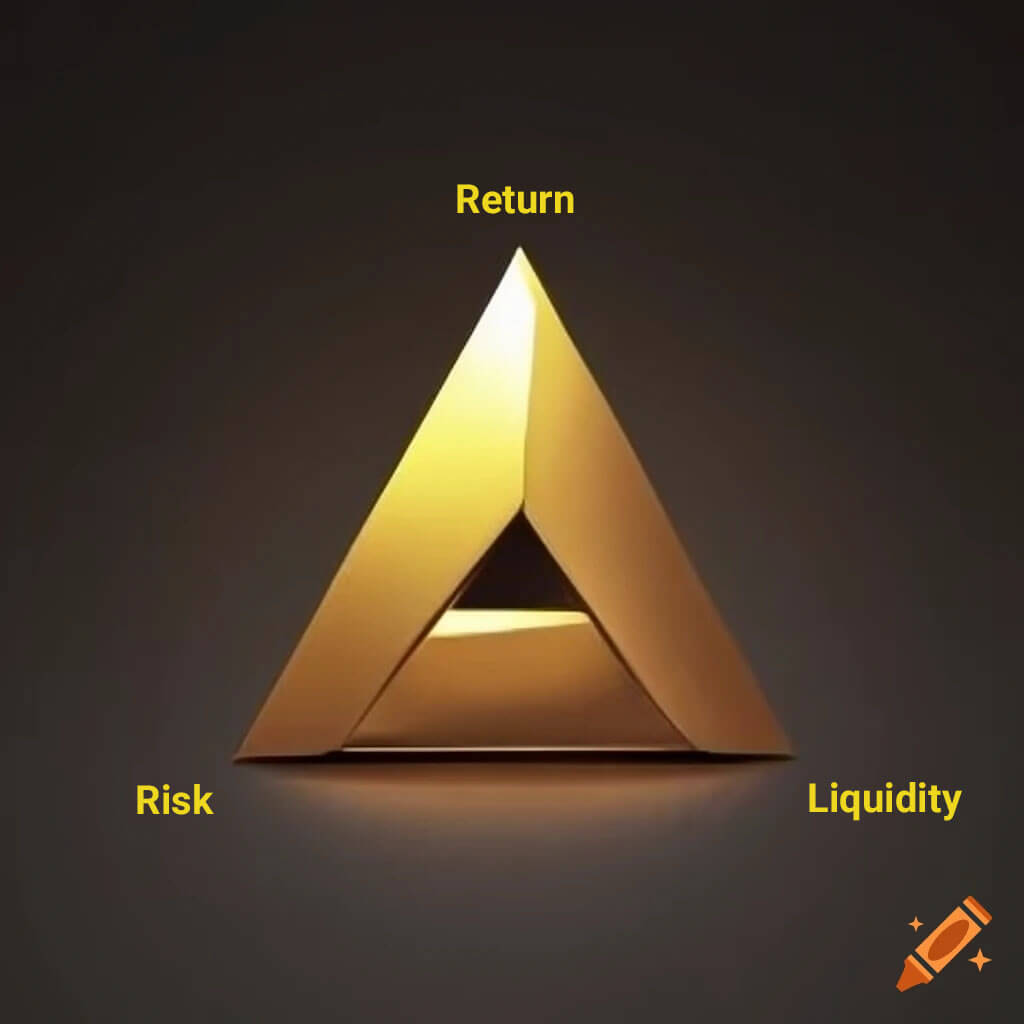Investment Triangle
The investment triangle is a useful tool for every investor. The vertices of the investment triangle consist of yield, risk, and liquidity. A clear explanation of individual elements, rules derived from the investment triangle, and examples.
Firstly, why do we invest? To increase wealth, in other words, achieve a certain return from invested funds. Investing is not without risk; the intended goal may not be achieved. And liquidity also plays a crucial role.
Let's explore the relationship between these variables, forming the vertices of the so-called investment triangle, sometimes referred to as golden or magical investment triangle (see the following image) in the following paragraphs. But first, let's look at individual items.

Figure – Investment Triangle (Source: Craiyon)
Return
Return is the sum of all incomes flowing to the investor from the investment.
Rule regarding the relationship between return and risk: It holds that if we demand a higher return, we usually have to accept higher risk. Or in other words, if we seek low risk and are unwilling to take too much risk, we usually have to settle for a lower return.
If we have two investments with the same (expected) return, we choose the investment with lower risk. If investments are equally risky, we choose the investment with a higher (expected) return. This implies that return can be actual—calculated based on historical data—or expected—based on our knowledge and estimation of future events.
Risk
We can generally define risk as a certain degree of danger that the desired goal will not be achieved. Translated to investments, it means that we may not achieve the desired return, or the actual return may differ from the expected return at the beginning of the investment.
Risk is related to time, to the uncertain future. We can measure or estimate risk using probability and statistics (dispersion and standard deviation). In this, risk terminology differs from uncertainty, where we cannot determine probabilities.
Risk can also be actual—based on historical data, we find out how much the actual return fluctuated around the expected return (for example, how the market price of a stock in which we invested moved)—or it can be expected risk—which we calculate based on probability.
Liquidity
Liquidity is the ability to convert an investment into cash quickly and with minimal costs. Speed and costs are crucial. Different assets or forms of property (stocks, bonds, real estate, gold) have different liquidity; it is easier or more difficult to convert them into cash.
Liquidity is primarily about the speed of conversion into money, but it must not be at the expense of selling below the market price. For example, stocks on the stock exchange can be sold almost instantly in a few seconds and with minimal costs. In contrast, the sale of real estate will not be as fast (except in situations where someone sells real estate significantly below the market price to quickly get cash).
Investment Triangle Rule
For every investment, we demand maximum return, minimum risk, and maximum liquidity.
The golden rule of the investment triangle states that we can only approach two vertices of the triangle simultaneously.
Examples
Stocks have a very high return and almost instant liquidity (at least for frequently traded blue chips companies), but it is challenging to meet the condition of minimum risk. Generally, higher return in stocks is offset by higher risk of not achieving the return or even incurring losses.
Real estates carry relatively decent returns and the risks are relatively low (although, for example, renting of real estate has many pitfalls), but liquidity is low—it is not easy to find a buyer quickly willing to pay the requested (undervalued) price, and the transaction itself takes time, such as when the money is released only after the new owner is registered in the land register etc.
Savings accounts have very low risk as deposits are legally insured up to $250,000 in USA and up to 100,000 euros in EU, very high liquidity (money can be immediately used, unlike term accounts), but returns are relatively poor (especially real returns that include inflation).
You Might Be Also Interested
- Investment vs Speculation;
- Investment Triangle Golden Rule;
- Stocks: Basics You Need to Know;
- Is Buying Stocks a Game of Chance?
- Dividend: What It Is and How to Get Them;
- Bonds: A Comprehensive Guide to Understanding Bonds;
- Cryptocurrencies: All You Need to Know;
- Bitcoin: A Comprehensive Guide;
- Investing in Gold as a Safe Haven;
- Price of Gold Surpassed the Historic Record from August 2020 (2023-12-04);
- Silver in Modern Society;
- Copper as a Barometer of the State of the Economy;
- Inflation: How to Protect Against It.
Based on the original Czech article: Investiční trojúhelník: výnos, riziko, likvidita.
